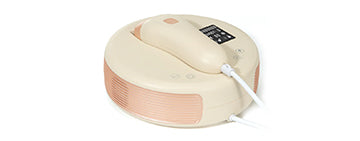The market is flooded with diverse devices and salon services promising smooth, hair-free skin. But amidst this plethora of options, a common dilemma arises between laser and IPL (Intense Pulsed Light) hair removal methods. Furthermore, this choice is compounded by another question: should one opt for professional salon treatments, or are at-home ways equally effective?
Understanding the Key Differences: Laser vs IPL
Understanding the fundamental differences between laser and IPL technologies is at the core of this decision-making process.
IPL: Broadband Pulsed Light Source
IPL devices emit a wide spectrum of light wavelengths. This broad range means the light is less concentrated, allowing it to target multiple hair follicles simultaneously. IPL's versatility is one of its standout features, enabling it to address various skin issues like sun damage and age spots, in addition to hair removal.
Laser: A Monochromatic Coherent Light Source
Laser treatments utilize a single, concentrated wavelength of light. This focused approach allows for greater precision in targeting hair follicles. Laser treatments can achieve faster results due to direct and intense light application to the follicle. Progress in laser technology has enabled its use on a more diverse range of skin tones, including those with darker skin tones that were previously deemed more challenging to treat.
IPL and laser technologies target the melanin in the hair follicle. Melanin absorbs light energy, converts to heat, and damages the follicle, inhibiting future hair growth. This process requires several treatment sessions, as it is most effective when hairs are growing.
Efficacy Factors: Energy, Frequency, and Hair Color
A variety of factors influence the success of both laser and IPL hair removal. Energy levels and the frequency of treatments are critical in determining the effectiveness of hair removal. Higher energy levels can target hair follicles more efficiently but must be balanced against the risk of skin irritation or damage, particularly in sensitive skin types.
Hair color also plays a significant role. IPL and laser treatments are most effective on dark hair, which has more melanin to absorb light. Lighter hair colors, such as blonde or gray, lack sufficient melanin, making them less responsive to these treatments.
Salon vs Home Treatments: Weighing the Options
Salon Treatments: Professional Expertise and Advanced Equipment
Skilled professionals can customize the strength of IPL or laser equipment based on each person's unique skin tone and hair shade, resulting in a safer and more successful salon experience. Salons also tend to have more advanced, powerful equipment, which delivers better results in fewer sessions.
At-Home Treatments: Privacy, Convenience, and Cost-Effectiveness
For those who value privacy and convenience, at-home IPL devices are a compelling option. These devices are designed for safe use by non-professionals and are generally user-friendly. While they may be less potent than their salon counterparts, at-home laser hair removal devices offer the flexibility to conduct hair removal at your own pace and in the comfort of your home. This saves time and can be more cost-effective in the long run, eliminating repeated salon visits.
Making the Right Choice
Many elements must be considered when determining the most suitable option among IPL, laser hair removal, and salon and home treatments. These include skin type, hair color, budget, and personal preferences regarding convenience and privacy. IPL and laser methods have their unique advantages and limitations. Whether choosing an IPL device for home use or professional laser treatments, both promise a significant reduction in body hair. The decision ultimately hinges on personal needs, lifestyle, and the specific outcomes one desires from the treatment. With advancements in both technologies continuing to evolve, the future of hair removal looks both promising and accessible, offering options that cater to a wide range of preferences and requirements. So, which hair removal method would you choose?










